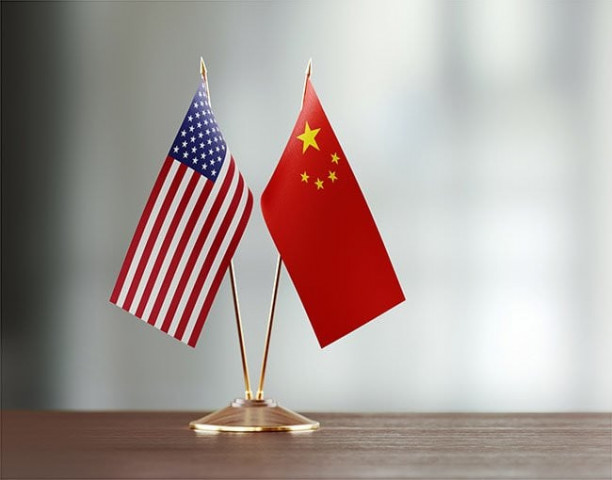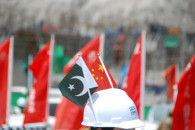US-China truce for stable global trade
Trade deal between world’s two largest economies likely as 90-day truce coming to an end

A trade deal between the world’s two largest economies is in sight as a 90-day truce between China and the United States is set to expire on Tuesday.
“Last month’s negotiations in Stockholm have advanced our talks with China, and I believe that we have the makings of a deal that will benefit both of our great nations,” US Treasury Secretary Scott Bessent wrote on microblogging platform “X” days after the third round of negotiations between the two countries in the Swedish capital on July 29.
Bessent’s tweet came on the heels of an announcement by President Donald Trump of trade deals with several countries which yielded to his pressure tactics, including Britain, Vietnam, Japan, Indonesia, the Philippines, and Pakistan – as well as the one with the 27-nation European Union.
The Stockholm negotiations – the first major engagement between Washington and Beijing following Geneva and London sessions – were described by both sides as “productive and fulsome”, despite yielding no tangible outcome.
Chinese Vice Premier He Lifeng led the Chinese delegation, accompanied by Commerce Minister Wang Wentao and WTO trade negotiator Li Chenggang.
On the American side, the negotiators included Treasury Secretary Bessent, Commerce Secretary Howard Lutnick, and Trade Representative Jamieson Greer.
The main objective was to negotiate a 90-day extension of truce agreed in mid-May, under which triple-digit tariffs were scaled back: the US from 145% to 30%, and Beijing from 125% to 10%.
The truce has thus far held but faces the August 12 deadline for renewal, or rejection. Indications are that the two sides would preserve the truce as Bessent sought to downplay the risk of escalation, saying “the meetings were very constructive. We just haven’t given the sign off.”
A trade war between the two top economies triggered by Trump’s sweeping “reciprocal” tariffs had created dangerous volatility in global markets and threatened to unravel the international trade system the US has protected vehemently post-World War II. However, Trump backed down, announcing a 90-day “pause” following the first trade meeting between the two sides in Geneva.
Beyond tariffs, the two global giants are also at loggerheads on a range of issues, including US demands that China’s ByteDance sell popular video-sharing platform TikTok to an American company and that Beijing speed up its export of critical minerals.
Analysts, however, argue that these tensions are driven more by geopolitics than economics as the United States views China’s rapid rise as a geostrategic threat to its global dominance – and is therefore seeking to contain it.
Trade Representative Greer also soft-pedaled the absence of a tangible outcome from the Stockholm meeting, saying that they didn’t yield a breakthrough but provided opportunities to monitor implementation of earlier commitments, including rare earth exports and semiconductor trade measures, and set the stage for deeper future engagement.
Rare earth minerals, technology export controls, market access and industrial overcapacity, and fentanyl-related tariffs were some of the key issues discussed in Stockholm.
China has partially resumed rare earth exports to the US following an agreement reached between Presidents Trump and Xi Jinping in early June. But the US side seeks clearer commitments around the volume and timing of these exports.
China has chokehold over rare earth magnets, which are critical for EVs and high-tech manufacturing.On technology export controls, the US has eased restrictions on Nvidia H20 AI chip exports to China.
Trump had stopped Nvidia from exporting to China its most powerful chipsets critical for developing cost-efficient AI models. The administration later reversed the ban on the condition that the chips will be equipped with tracking and positioning functions.
The Cyberspace Administration of China, the country’s internet regulator, however, voiced concerns over potential “backdoor” security risks, fearing that Chinese user data and privacy rights could be affected. Nvidia denied its chips have any hidden method of bypassing normal authentication or security controls.
On market access and industrial overcapacity, Chinese negotiators pressed concerns over US tariffs, dual-use exports, and the electoral impact of Chinese state-backed overcapacity flooding global markets.
The American side demanded better access for US firms and tighter control on industrial subsidies.
On fentanyl-related tariffs, the Trump administration continues to levy higher tariffs on China over its alleged role in fentanyl trade. China has sought clarification on what constitutes sufficient action for a tariff rollback during the Stockholm discussions. Treasury Secretary Bessent said that they touched on US concerns over China’s purchase of Iranian oil, supplying Russia with dual-use tech that could be used on the battlefield, and manufacturing goods at a pace beyond what is sustained by global demand.
On August 2, President Trump signed an executive order that further modified tariff rates with 69 trading partners, imposing “additional ad valorem duties on goods of certain trading partners,” including long-term allies like Canada and the European Union, with rates ranging from 10% to 40%.
The move has drawn widespread criticism with detractors accusing Trump of reversing decades of globalisation that made America’s massive services economy the envy of the world but contributed to its long decline in manufacturing. Trump expressed cautious optimism about the Stockholm talks. However, senior US officials stressed that the final decision on preserving the truce remains his alone.
Observers are watching for a potential Trump-Xi summit later this year, possibly during the APEC meeting in South Korea in late October or early November – an encounter analysts say could solidify any truce and pave the way for broader structural reforms in trade relations.
At Stockholm, China’s Vice Premier He Lifeng said the two nations share extensive common interests and a broad space for cooperation in the economy and trade areas. “Cooperation between them benefits both sides, while confrontation harms both sides,” he added.
“A stable, healthy and sustainable China-US economic and trade relationship serves not only the two countries’ respective development goals but also contributes to global economic growth and stability.”
The Chinese vice premier’s assessment aligns with the views of international financial institutions. The IMF has warned that escalation of tariffs poses serious risks to global economic growth and inflation. While the Geneva truce prompted a modest upgrade to the IMF’s 2025 global GDP outlook to 3%, analysts caution that uncertainty in trade policy would continue weighing on business confidence unless the two top economies reach a durable trade deal.
The onus now lies with President Trump who has been accused of weaponising tariffs even at the expense of America’s global leadership role.
The writer is a student and freelance contributor with special interest in geopolitics and geo-economics



















COMMENTS
Comments are moderated and generally will be posted if they are on-topic and not abusive.
For more information, please see our Comments FAQ